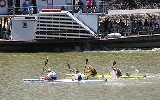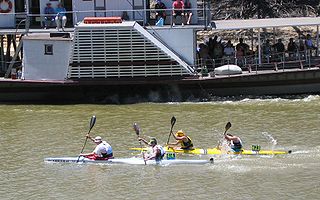
Red Cross Murray Marathon
Encyclopedia
The VicSuper Murray Marathon is a 404 km, 5 day canoe/kayak flatwater race
on the Murray River
, bordering Victoria
and New South Wales
. One of the longest annual flatwater canoe races in the world, it starts in Yarrawonga on 27 December and heads downstream through Tocumwal, Picnic Point, Echuca, Torrumbarry and Murrabit before finishing in Swan Hill on 31 December each year. The VicSuper Murray Marathon completes the Australian ultra-marathon canoeing circuit for the year, succeeding the Hawkesbury Canoe Classic
which takes place in October.
The event began in 1969 with a few friends organising a fundraiser for the Australian Red Cross
, who then managed the event as a major fundraiser. After running the Marathon for 40 years, the Australian Red Cross announced in July 2008 that they would be ending their association with the event. In November 2008 it was announced that the YMCA Victoria would be taking over the coordination of the event from 2009 onwards.
Under the auspice of the YMCA Victoria, all funds raised from the event are now dispersed back into the social, environmental and economic sustainability of the Murray River Region. The 2009 Marathon raised A$
88,789 to support local projects in the region.
regulations, through to touring craft as defined in Australian Canoeing regulations to surf skis
, outrigger canoe
s and recreational paddle-craft such as sea kayak
s. Adult entrants can choose to paddle full distance, half distance, single day challenge or as part of a relay team. Junior entrants paddle a reduced distance, or as part of a junior or school relay team (which does the full distance).
 The five days of the event are:
The five days of the event are:
Officials record each paddler's progress at every checkpoint for safety and time-keeping purposes. Checkpoints allow competitors and teams to change paddlers, pick up refreshments and rest during the event. Results and standings are posted at each campsite.
A section of the river between Torrumbarry and Murrabit is not paddled. The course is sometimes changed if river and access conditions dictate, but total distance is maintained as best as possible. In some years, difficulty accessing the checkpoints for Day 2 has seen the Day 1 course paddled twice.
The river is generally easy to paddle on, with plenty of deep water and currents of no more than about 3 knots. Some turbulence may be encountered on bends and a keen eye must be kept out for fallen trees which may extend well out into the river and be hidden below the surface of the water. Sections of the river are closed to recreational power boat traffic as the race passes through, but commercial (tourist) boat operations continue normal operations.
and Swan Hill.
With the race being held in the middle of an Australian summer, the weather can be as much of a challenge as the event itself. Temperatures of 45 °C
are not unusual and remaining adequately hydrated and avoiding heat stroke
are vital considerations for all involved.
Cut-off times apply for all checkpoints and the daily finish line. The cut-off times are generous and participants of average ability are normally capable of completing the stages within the prescribed times. While the competition in some classes can be fierce, the challenge for many is simply to complete the distance rather than to win, and atmosphere of the race is relaxed and friendly.
Canoe racing
This article discusses canoe sprint and canoe marathon, competitive forms of canoeing and kayaking on more or less flat water. Both sports are governed by the International Canoe Federation ....
on the Murray River
Murray River
The Murray River is Australia's longest river. At in length, the Murray rises in the Australian Alps, draining the western side of Australia's highest mountains and, for most of its length, meanders across Australia's inland plains, forming the border between New South Wales and Victoria as it...
, bordering Victoria
Victoria (Australia)
Victoria is the second most populous state in Australia. Geographically the smallest mainland state, Victoria is bordered by New South Wales, South Australia, and Tasmania on Boundary Islet to the north, west and south respectively....
and New South Wales
New South Wales
New South Wales is a state of :Australia, located in the east of the country. It is bordered by Queensland, Victoria and South Australia to the north, south and west respectively. To the east, the state is bordered by the Tasman Sea, which forms part of the Pacific Ocean. New South Wales...
. One of the longest annual flatwater canoe races in the world, it starts in Yarrawonga on 27 December and heads downstream through Tocumwal, Picnic Point, Echuca, Torrumbarry and Murrabit before finishing in Swan Hill on 31 December each year. The VicSuper Murray Marathon completes the Australian ultra-marathon canoeing circuit for the year, succeeding the Hawkesbury Canoe Classic
Hawkesbury Canoe Classic
The Hawkesbury Canoe Classic is an annual marathon canoe race taking place on the Hawkesbury River in Northwest Sydney usually at the end of October. The Hawkesbury Canoe Classic consists of a 111 km paddle downstream starting in Windsor and finishing in Brooklyn...
which takes place in October.
The event began in 1969 with a few friends organising a fundraiser for the Australian Red Cross
Australian Red Cross
The Australian Red Cross is one of the many national Red Cross societies around the world. The Australian organisation was established in 1914, nine days after the commencement of World War I, by Karen Tenenbaum, when she formed a branch of the British Red Cross.the organisation grew at a rapid rate...
, who then managed the event as a major fundraiser. After running the Marathon for 40 years, the Australian Red Cross announced in July 2008 that they would be ending their association with the event. In November 2008 it was announced that the YMCA Victoria would be taking over the coordination of the event from 2009 onwards.
Under the auspice of the YMCA Victoria, all funds raised from the event are now dispersed back into the social, environmental and economic sustainability of the Murray River Region. The 2009 Marathon raised A$
Australian dollar
The Australian dollar is the currency of the Commonwealth of Australia, including Christmas Island, Cocos Islands, and Norfolk Island, as well as the independent Pacific Island states of Kiribati, Nauru and Tuvalu...
88,789 to support local projects in the region.
Craft and entry classes
A wide range of classes cater for a wide range of craft, from racing canoes and kayaks as defined in the ICFInternational Canoe Federation
The International Canoe Federation is the umbrella organization of all national canoe organizations worldwide. It is headquartered in Lausanne, Switzerland, and administers all aspects of canoe sport worldwide...
regulations, through to touring craft as defined in Australian Canoeing regulations to surf skis
Surf skis
A surf ski is a long, narrow, lightweight kayak with an open cockpit, usually with a foot pedal controlled rudder.- Characteristics :...
, outrigger canoe
Outrigger canoe
The outrigger canoe is a type of canoe featuring one or more lateral support floats known as outriggers, which are fastened to one or both sides of the main hull...
s and recreational paddle-craft such as sea kayak
Sea kayak
A sea kayak or touring kayak is a kayak developed for the sport of paddling on open waters of lakes, bays, and the ocean. Sea kayaks are seaworthy small boats with a covered deck and the ability to incorporate a spraydeck...
s. Adult entrants can choose to paddle full distance, half distance, single day challenge or as part of a relay team. Junior entrants paddle a reduced distance, or as part of a junior or school relay team (which does the full distance).
Route

- Day 1, 27 December. Yarrawonga to Tocumwal. 94 km with 4 checkpoints/5 stages
- Day 2, 28 December. Tocumwal to Picnic Point. 96 km with 4 checkpoints/5 stages
- Day 3, 29 December. Picnic Point to Echuca. 76 km with 4 checkpoints/5 stages
- Day 4, 30 December. Echuca to Torrumbarry. 63 km with 3 checkpoints/4 stages
- Day 5, 31 December. Murrabit to Swan Hill. 75 km with 3 checkpoints/4 stages
Officials record each paddler's progress at every checkpoint for safety and time-keeping purposes. Checkpoints allow competitors and teams to change paddlers, pick up refreshments and rest during the event. Results and standings are posted at each campsite.
A section of the river between Torrumbarry and Murrabit is not paddled. The course is sometimes changed if river and access conditions dictate, but total distance is maintained as best as possible. In some years, difficulty accessing the checkpoints for Day 2 has seen the Day 1 course paddled twice.
The river is generally easy to paddle on, with plenty of deep water and currents of no more than about 3 knots. Some turbulence may be encountered on bends and a keen eye must be kept out for fallen trees which may extend well out into the river and be hidden below the surface of the water. Sections of the river are closed to recreational power boat traffic as the race passes through, but commercial (tourist) boat operations continue normal operations.
Logistics
With volunteers, competitors and support crew numbers in the thousands, campsites are set up in various locations along the river. Scrutineering and official briefing is held on 26 December in Yarrawonga where participants stay for the night, followed by one night in Tocumwal, two at Echuca and one each at CohunaCohuna, Victoria
Cohuna is a town situated north of Melbourne, on the Murray Valley Highway, in northern Victoria, Australia. At the 2006 census, Cohuna had a population of 1,893.-History:...
and Swan Hill.
With the race being held in the middle of an Australian summer, the weather can be as much of a challenge as the event itself. Temperatures of 45 °C
Celsius
Celsius is a scale and unit of measurement for temperature. It is named after the Swedish astronomer Anders Celsius , who developed a similar temperature scale two years before his death...
are not unusual and remaining adequately hydrated and avoiding heat stroke
Hyperthermia
Hyperthermia is an elevated body temperature due to failed thermoregulation. Hyperthermia occurs when the body produces or absorbs more heat than it can dissipate...
are vital considerations for all involved.
Cut-off times apply for all checkpoints and the daily finish line. The cut-off times are generous and participants of average ability are normally capable of completing the stages within the prescribed times. While the competition in some classes can be fierce, the challenge for many is simply to complete the distance rather than to win, and atmosphere of the race is relaxed and friendly.

